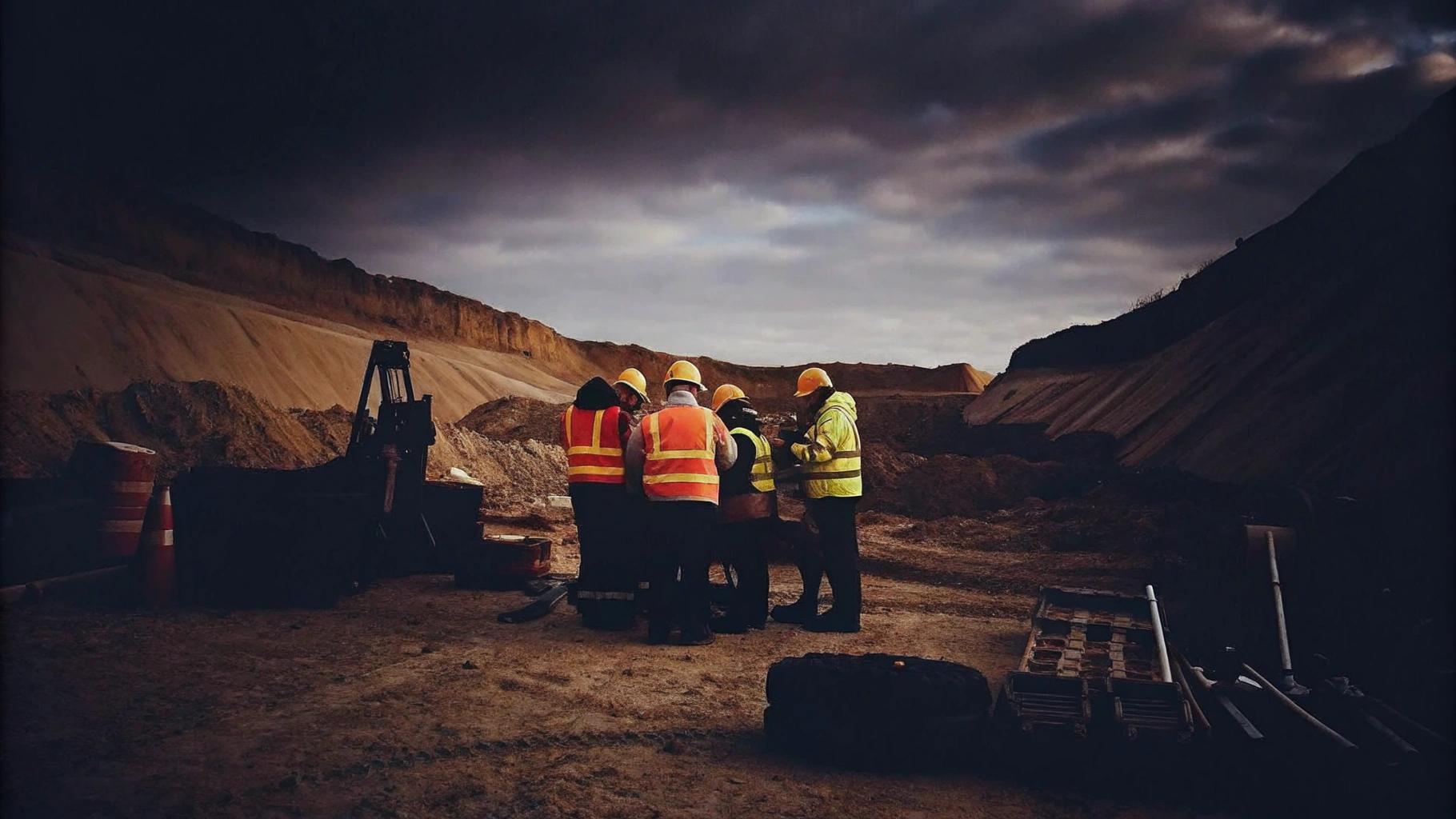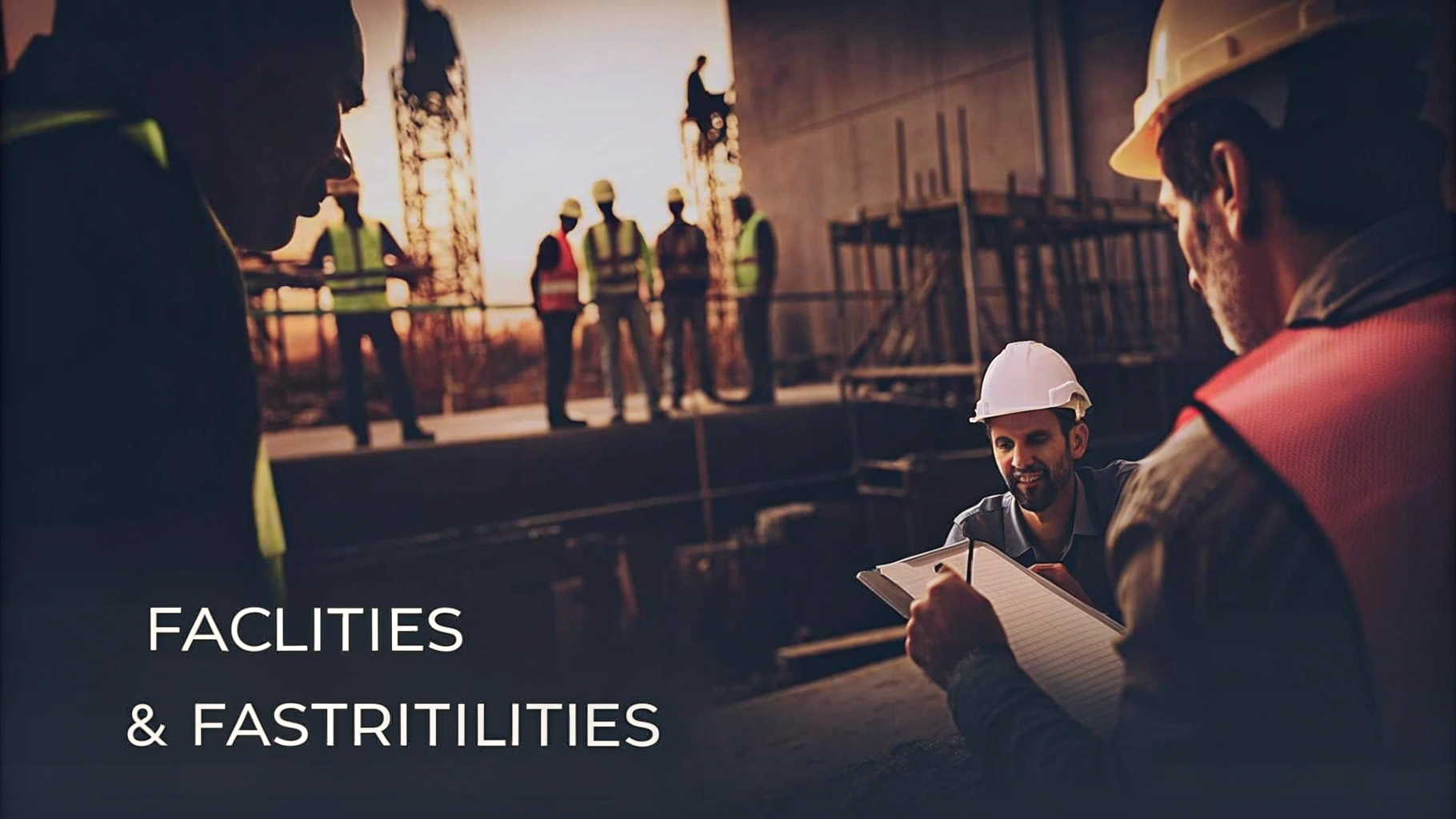
10 Key Benefits of Facilities Management Near You for Construction Sites

Overview
The article outlines ten key benefits of facilities management for construction sites, emphasising its role in enhancing safety, efficiency, compliance, and overall project success. Each benefit, such as tailored security solutions, technology integration, and cost efficiency, illustrates how effective facilities management not only protects assets and personnel but also optimises operations and promotes a positive work environment. This ultimately contributes to the profitability of construction endeavours.
Introduction
Facilities management is crucial in the construction industry, underpinning safety, efficiency, and overall project success. Understanding the various benefits that tailored facilities management strategies provide can unlock significant opportunities for improved operational performance and cost savings. The reality is that construction managers face the challenge of effectively integrating these practises amidst the complexities of modern building projects while ensuring compliance and safeguarding their workforce. This article examines ten key benefits of facilities management that not only enhance project outcomes but also promote a culture of safety and sustainability on construction sites.
Priority First Security Services: Tailored Protection for Facilities Management
Priority First Security Services delivers personalised protection solutions tailored to the specific needs of facility oversight, particularly in building environments. Their extensive range of services includes on-site security teams, advanced 24/7 CCTV monitoring, and tailored logistics management, ensuring comprehensive safeguarding against theft, vandalism, and other risks. This customised approach not only protects physical assets but also fosters a secure environment for employees, allowing operations to proceed without disruption.
Security specialists emphasise that a customised strategy is essential for addressing the unique vulnerabilities of each project. The successful implementation of these tailored protection services has led to a significant enhancement in safety at construction sites. For example, Priority First's deployment of Rapid Deployment CCTV Towers provides near-360° surveillance, facilitating real-time alerts and proactive monitoring. This deters unlawful activities while promoting a safe working environment, enabling projects to progress without interruptions.
Moreover, Priority First excels in integrating its services with existing security systems, ensuring a seamless enhancement of current setups. The significance of tailored security services extends beyond asset protection; it is pivotal in maintaining compliance with safety regulations and minimising liability. By prioritising customised security strategies, project managers can effectively mitigate risks, ensuring their projects remain on schedule and uphold their reputations. A case study involving a multi-use complex in Chelsea highlights how Priority First's comprehensive security solutions adeptly managed risks and improved safety, underscoring the effectiveness of their tailored approach. Ultimately, investing in is not merely a protective measure but a strategic investment in the overall success and continuity of building operations.

Technology Integration: Streamlining Operations in Facilities Management
The integration of advanced technologies, particularly AI-driven surveillance systems and predictive analytics, is crucial for enhancing near me on building sites. Intelligent CCTV monitoring, equipped with automated threat detection and behavioural analysis software, significantly bolsters security by identifying suspicious activities in real time. This proactive approach mitigates risks and streamlines operational efficiency. AI can predict potential equipment failures, minimising downtime and prolonging asset lifespan. Moreover, these technologies offer practical insights that allow quick reactions to new challenges, ensuring that building projects stay on track and within budget.
Alongside these technologies, integrating Hostile Vehicle Mitigation (HVM) strategies is essential for protecting building sites. HVM involves physical measures such as barriers, bollards, and reinforced planters to prevent vehicles from posing a threat, which is increasingly relevant given the rise in vehicle-based attacks. By integrating HVM with manned guarding and CCTV monitoring, building sites can create a comprehensive security strategy that not only protects assets but also reassures staff and visitors. As emphasised by industry leaders, the adoption of predictive analytics and HVM is transforming site operations, promoting a safer and more efficient working environment. A notable example is the predictive maintenance strategy, where AI continuously monitors building operational systems to forecast equipment failures before they occur, effectively reducing repair costs and downtime.

Compliance and Safety Assurance: Protecting Assets and People
Ensuring adherence to health and safety standards is critical in facilities oversight, particularly within the building industry. Facilities management near me teams are instrumental in enforcing safety protocols, which mitigates risks to workers and protects valuable assets. Regular safety audits serve as a cornerstone of this process, enabling teams to identify potential hazards and implement corrective measures proactively. A recent audit at a major construction site, for instance, uncovered significant gaps in safety training, prompting immediate action that notably reduced incident rates.
for staff are equally essential, equipping them with the knowledge to effectively recognise and respond to safety issues. Clear communication channels regarding safety procedures cultivate a culture of safety awareness, ensuring that all personnel remain informed and vigilant. As industry experts highlight, "A strong safety culture not only safeguards personnel but also improves overall work efficiency."
By prioritising compliance and conducting thorough safety audits, facilities management near me can foster a safer work environment that not only protects personnel but also contributes to the successful completion of projects. The integration of safety audits into building site oversight transcends mere regulatory necessity; it represents a strategic approach that enhances operational performance and reduces risk.

Employee Health and Wellness: A Core Benefit of Facilities Management
Facilities oversight is critical for promoting employee health and wellness, particularly within the demanding environment of construction sites. By ensuring clean, well-equipped workplaces and integrating security solutions, managers foster an atmosphere that significantly enhances worker satisfaction and productivity. Priority First offers tailored security solutions, including manned guarding and CCTV monitoring, which bolster management efforts to maintain a secure and compliant environment.
Key initiatives, such as ergonomic workspaces, improve comfort and reduce the risk of injury, resulting in a more engaged workforce. Access to mental health resources and wellness programmes further supports employees, nurturing a culture of wellbeing that translates into enhanced results. Furthermore, amenities like exercise spaces and relaxation zones can elevate satisfaction levels, making employees feel valued and cared for.
Ultimately, a strategic focus on not only cultivates a healthier workforce but also drives improved performance and success in construction projects.

Cost Efficiency: Budgeting and Financial Management in Facilities Management
Cost efficiency is vital in operations related to buildings, particularly in the construction industry, where budget constraints are commonplace. Facilities managers must develop comprehensive financial strategies that encompass all operational aspects, including security services and maintenance costs, to improve facilities management near me.
By adopting technology-driven solutions such as predictive maintenance, managers can significantly lower operational expenses while maintaining safety and compliance standards. This proactive budgeting approach not only leads to substantial savings but also improves the near me.
For example, the implementation of a Computer-Aided Facilities Management (CAFM) system can automate routine tasks, decreasing the time spent on administrative duties by up to a third of the working week. This transition allows teams to focus on critical maintenance tasks, ultimately enhancing efficiency and reducing the likelihood of costly delays.
Furthermore, financial experts emphasise that effective budgeting in construction projects requires a strategic viewpoint, particularly in resource management and anticipating potential challenges. Real-world cases demonstrate that organisations utilising predictive maintenance strategies have experienced notable decreases in equipment failure rates, resulting in lower repair costs and extended asset lifespans.
By prioritising cost efficiency through innovative facilities management near me practises, building locations can achieve not only financial stability but also operational excellence.

Vendor and Supply Management: Ensuring Operational Continuity
Efficient vendor and supply oversight is essential for ensuring operational continuity in service environments, particularly on construction sites that depend on a diverse array of vendors for services ranging from security to maintenance.
Building strong connexions with these suppliers is critical; managers must ensure that vendors consistently meet quality standards and deliver services punctually.
By implementing a structured vendor oversight framework, facilities management near me can streamline procurement processes, negotiate advantageous contracts, and maintain consistent service levels.
This proactive approach not only but also significantly contributes to the overall success of construction projects.
As industry experts emphasise, maintaining robust vendor relationships is a cornerstone of effective supply chain operations, enabling firms to address challenges and enhance outcomes.

Environmental Sustainability: Enhancing Corporate Responsibility
Environmental sustainability is essential in facilities management near me, especially within the building sector, where initiatives can significantly affect the environment. In facilities management near me, facilities managers are pivotal in executing sustainable practises, such as waste reduction, energy efficiency, and the utilisation of eco-friendly materials. By prioritising these initiatives, they not only comply with regulations but also enhance their organisation’s corporate responsibility profile. This dedication to environmental stewardship cultivates a positive public perception and attracts clients who value sustainability.
Industry leaders underscore that integrating eco-friendly practises is not merely beneficial but vital for the future of the building sector. For example, the U.K. Green Building Council indicates that over 60% of construction initiatives are now adopting green building best practises, highlighting a significant trend toward sustainability. Furthermore, using concrete with recycled aggregates of up to 43% can conserve as much as 37% of raw materials compared to traditional concrete, illustrating the substantial impact of eco-friendly materials on outcomes.
Successful waste reduction initiatives, such as the implementation of recycled aggregates in concrete, demonstrate how sustainable practises can transform project execution while minimising environmental impact. Ultimately, in operational oversight is a strategic decision that aligns with broader corporate responsibility objectives and positions organisations as leaders in the evolving building landscape.
Emergency Preparedness: Safeguarding Against Unexpected Events
Emergency readiness is essential in managing spaces, particularly in building environments where unexpected events can arise. Facilities managers are responsible for developing comprehensive emergency response plans that encompass a range of scenarios, including natural disasters, accidents, and security threats. These plans must adhere to legal standards such as the Health and Safety at Work Act 1974 and the Construction (Design and Management) Regulations 2015, establishing a solid framework for safety.
Regular training and drills are critical for staff to become familiar with these procedures, fostering a culture of readiness and accountability. Effective training programmes not only bolster employee confidence but also ensure that all personnel comprehend their specific roles during emergencies, including first aiders and fire safety marshals. This proactive strategy reduces the risk of confusion and delays in response, which can worsen crises.
The impact of well-organised emergency response plans on site safety cannot be overstated. By identifying potential hazards and establishing clear communication protocols, managers can significantly decrease the likelihood of accidents and ensure a swift response when incidents occur. Collaborating with local emergency services and conducting regular practise drills further enhances the team's preparedness, facilitating a coordinated response that safeguards both personnel and assets.
Incorporating feedback from training exercises is vital for refining these plans, making them adaptable to changing risks and technological advancements. Ultimately, a commitment to not only protects workers but also enhances operational continuity, contributing to the overall success and financial stability of building projects.

Space Utilization Optimization: Enhancing Efficiency in Facilities Management
Improving space usage is essential for enhancing efficiency in facilities management near me, particularly in construction projects where space constraints are common. Facilities management near me requires managers to regularly assess space utilisation to identify underutilised areas, allowing for the implementation of strategies that maximise their potential. This may involve:
- Reconfiguring layouts
- Utilising multi-functional spaces
- Adopting flexible work arrangements
Effective space organisation, supported by facilities management near me, not only improves workflow but also reduces costs and fosters a more efficient environment for employees.
Experts emphasise that a well-planned space can significantly enhance task efficiency. For example, incorporating natural elements and quiet areas can boost employee well-being, which is crucial for maintaining high morale on-site. Furthermore, employing occupancy sensors and workplace analytics tools enables managers to make data-driven decisions regarding office layouts and resource allocation, ensuring that every square foot is effectively utilised.
Examples of successful space organisation strategies in construction initiatives include:
- The use of modular workstations that can be easily reconfigured as needs change
- The establishment of designated collaboration areas that promote teamwork while minimising disruption
By implementing these practises, facilities management near me can create environments that not only meet operational demands but also support the well-being of their workforce, ultimately leading to more successful outcomes.

Business Success: The Comprehensive Impact of Facilities Management
Facilities oversight is essential for enhancing profitability in the building sector. By meticulously supervising various aspects—ranging from security and compliance to employee well-being and cost efficiency—facilities managers significantly improve the effectiveness of construction endeavours. Priority First offers tailored security solutions, including manned guarding, CCTV surveillance, and access control, as part of an integrated service offering. This holistic approach not only boosts operational performance but also fosters a , crucial for achieving successful project outcomes and ensuring client satisfaction.
Current trends indicate that the infrastructure oversight market is projected to exceed USD 2 trillion by 2030, with a compound annual growth rate surpassing 6.7%. This growth highlights the increasing recognition of infrastructure oversight as a strategic investment for organisations. Efficient premises oversight optimises physical resources, leading to reduced operational expenses and enhanced effectiveness, which are vital for maintaining profitability in construction.
Practical examples illustrate the impact of infrastructure oversight on construction profitability. For instance, integrating operational considerations during the design phase can prevent future maintenance issues, ensuring functional layouts and improved integration of building services. This proactive approach not only reduces costs over a building's lifespan but also promotes sustainability and operational efficiency.
Industry leaders emphasise the importance of infrastructure oversight in project profitability. As Matt Werner, VP of Real Estate & Workplace Services at Google, notes, managing energy expenses will be a critical component of operational oversight in the coming years. By implementing energy-saving strategies, managers can significantly lower utility costs, thereby improving overall financial performance.
In conclusion, effective facilities management near me, particularly when combined with bespoke security solutions from Priority First, is foundational to successful construction projects. It drives profitability through enhanced operational performance, strategic cost management, and a commitment to employee well-being.
Conclusion
Effective facilities management is essential for the success of construction sites, offering a range of benefits that enhance operational efficiency, safety, and overall project outcomes. By prioritising tailored security solutions, integrating advanced technology, ensuring compliance with safety regulations, and promoting employee wellness, facilities management safeguards physical assets while fostering a productive work environment. This comprehensive approach guarantees that construction projects stay on schedule and within budget, ultimately driving profitability.
Key insights throughout the article underscore the significance of:
- Customised security strategies
- The integration of cutting-edge technologies
- A commitment to health and safety protocols
Regular audits, effective vendor management, and sustainable practises further contribute to operational excellence. The focus on emergency preparedness and optimising space utilisation illustrates how proactive measures can mitigate risks and enhance efficiency, positioning facilities management as a crucial component of successful construction operations.
In conclusion, the importance of facilities management transcends mere oversight; it represents a strategic investment that boosts business performance and fosters corporate responsibility. As the construction industry evolves, adopting innovative facilities management practises will be vital for organisations seeking to thrive in a competitive landscape. By acknowledging the multifaceted benefits of effective facilities management, stakeholders can ensure not only the continuity of their projects but also the long-term success of their operations.
Frequently Asked Questions
What services does Priority First Security Services offer for facilities management?
Priority First Security Services provides personalised protection solutions, including on-site security teams, 24/7 CCTV monitoring, and tailored logistics management, aimed at safeguarding against theft, vandalism, and other risks.
Why is a customised security strategy important in facilities management?
A customised security strategy is essential for addressing the unique vulnerabilities of each project, enhancing safety, and ensuring operations can proceed without disruption.
How does Priority First enhance safety at construction sites?
Priority First enhances safety through the deployment of Rapid Deployment CCTV Towers, which provide near-360° surveillance, facilitate real-time alerts, and promote proactive monitoring to deter unlawful activities.
What role does technology play in facilities management?
Advanced technologies, such as AI-driven surveillance systems and predictive analytics, enhance facilities management by identifying suspicious activities in real time, predicting equipment failures, and streamlining operational efficiency.
What are Hostile Vehicle Mitigation (HVM) strategies?
HVM strategies involve physical measures like barriers and bollards to prevent vehicles from posing threats to building sites, which is increasingly relevant due to the rise in vehicle-based attacks.
How do safety audits contribute to facilities management?
Safety audits help identify potential hazards and implement corrective measures, ensuring adherence to health and safety standards, which mitigates risks to workers and protects valuable assets.
Why is staff training important in facilities management?
Staff training equips personnel with the knowledge to recognise and respond to safety issues, fostering a culture of safety awareness that enhances overall work efficiency.
How do compliance and safety assurance benefit building projects?
Prioritising compliance and conducting safety audits contribute to a safer work environment, protect personnel, and help ensure the successful completion of projects by reducing risks.




